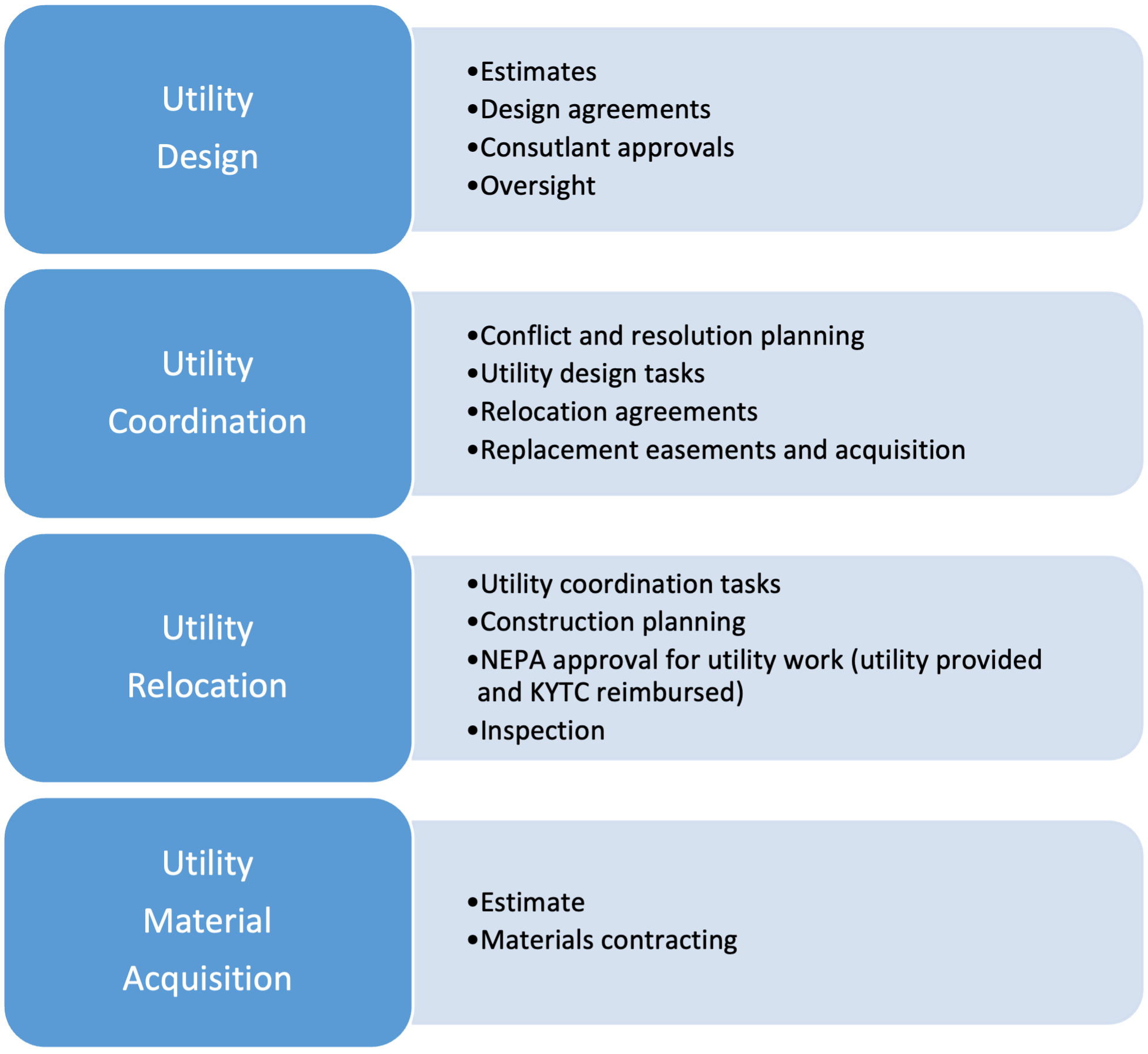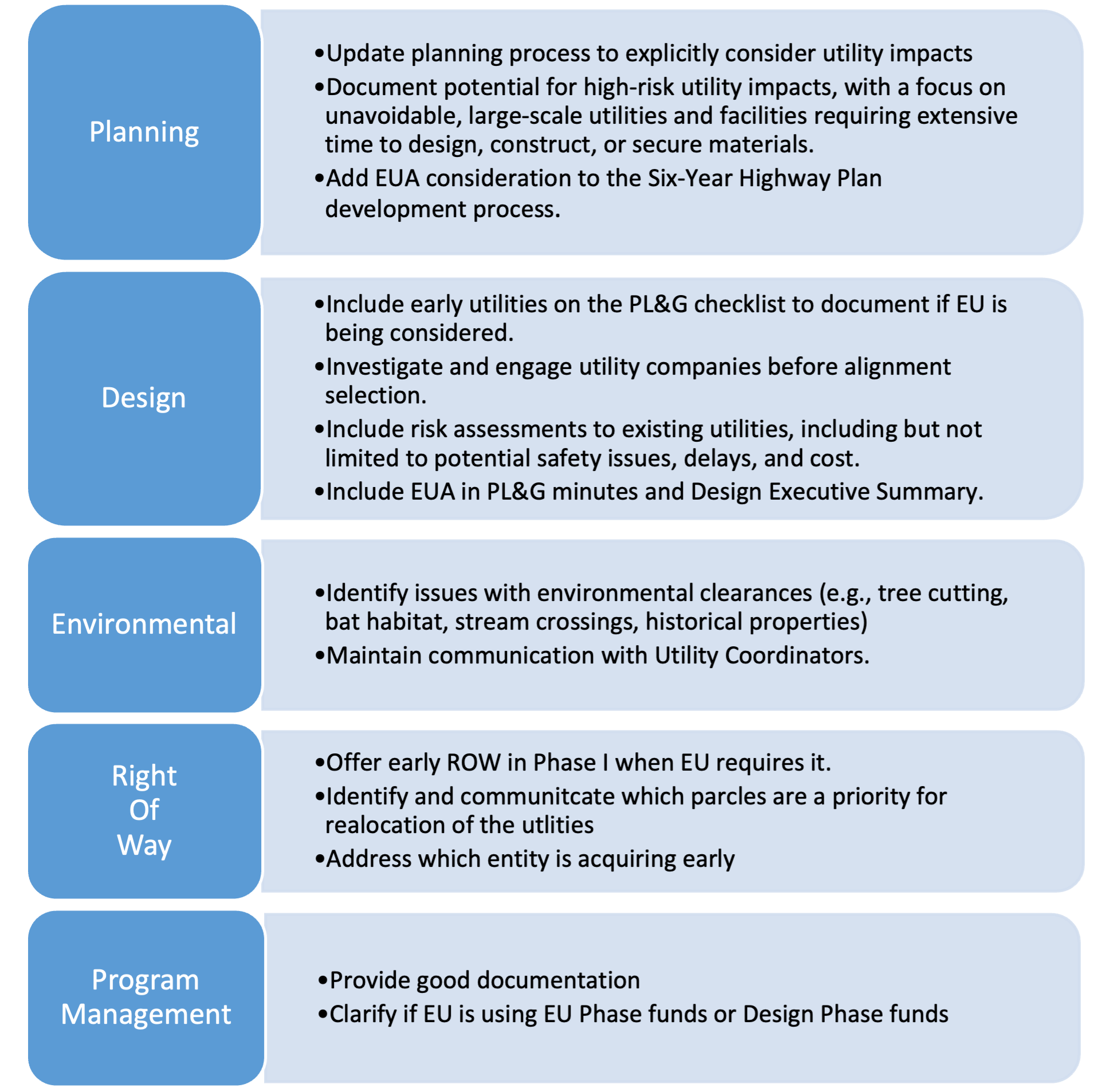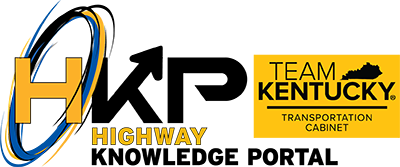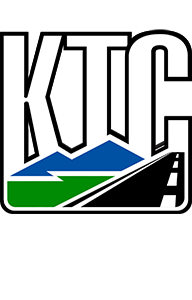Search for articles or browse our knowledge portal by topic.
Early Utility Accommodation
Authorized under 23 USC Section 123, Early Utility Accommodation (EUA) lets state transportation agencies carry out utility relocation projects on a transportation project before environmental review (NEPA) is complete on the transportation project. EUA includes one or more of the following activities:
- Utility design services
- Utility coordination services
- Utility relocation construction
- Acquisition of specialty utility materials

Side Note
When utilities are relocated before a transportation project receives NEPA approval, the Cabinet uses state funds to pay for construction. KYTC may request federal reimbursement once the transportation project is approved for construction.
Red Flag
To be eligible for federal reimbursement, a utility relocation project must undergo its own environmental review. This review must confirm the project:
- Has no significant adverse environmental impacts.
- Complies with relevant environmental requirements, laws, regulations, statutes, and policies.
- Does not impact the transportation project’s environmental review process.
- Does not factor into the need to construct the transportation project or its design.
To qualify for EUA, transportation projects must meet three project criteria, and the project scope must comply with several requirements. These are listed in Checklist 1.
| Checklist 1: EUA Project Criteria and High-Level Scoping Requirements | |
| Project Criteria | Check Box |
| Title 23 eligible | |
| Included in Kentucky’s Statewide Transportation Improvement Program (STIP) and/or the regional/local transportation improvement program (TIP) | |
| Is NOT a LPA project | |
| Scope Requirements | Check Box |
| Generates no significant adverse environmental impacts on the transportation project | |
| Does not impact critical/costly environmental features | |
| Is required to address a transportation project | |
| Complies with state and federal policies, laws, and regulations | |
KYTC created a task force to create minimum EUA criteria and develop a process. The task force included personnel from:
- Legal
- Planning
- Design
- Environmental
- Program Management
- ROW
- Utilities
3.1 General EAU Criteria
KYTC recommends opting for EUA if any of the following conditions apply:
- The project includes unavoidable utility relocations.
- Design, construction, or procurement of materials is expected to take a significant amount time.
- Relocations involve large-scale facilities (e.g., buildings, pump stations, treatment facilities).
- Relocations will be on existing right of way (ROW).
- With EUA, utility relocations begin before the traditional ROW process is complete. As such, it is advantageous if facilities can be relocated on state-owned ROW.
- Projects located outside historic districts and/or environmentally sensitive areas.
The following project types are potential candidates for EUA:
- Priority projects
- Projects with a firm deadline to construct
- Projects with a firm/set alignment
- New corridors or roadways with a large-scale utility facility
- Projects with no critical environmental features (e.g., endangered species)
3.2 EUA for Design & Coordination
Criteria for pursuing utility coordination and design services under EUA are listed below.
- The preference is to use a state-funded Early Utility (EU) Phase. However, if no relocations or material acquisition is required, Design Phase funds may be used to pay for design and coordination services (if the project budget permits).
- EU scope includes ROW/replacement easement. If KYTC is acquiring a replacement easement, it must be transferred to the utility company once the project complete.
- KYTC must implement early ROW acquisition and acquire:
- Necessary ROW parcels (by KYTC)
- Replacement easement (through utility company or KYTC)
- If a parcel includes both they should be acquired in a single acquisition (by KYTC)
- If a utility company is acquiring a replacement easement and is eligible to condemn the easement, the agreement between KYTC and the utility company must require the latter to condemn.
3.3 EUA for Material Acquisition
Criteria for acquiring material before NEPA approval are listed below.
- Must use a state-funded EU Phase.
- Materials being acquired via EU must be documented as having at least one of the following characteristics:
- Are in limited supply.
- Costs are expected to increase > 20% before a standard utility agreement would be available.
- Require an acquisition lead time of at least 6 months.
- Are in high demand and likely to become unavailable before construction.
- Require extensive engineering or specially design pieces.
Additional considerations for early utility material acquisition projects include:
- Any restocking fees or penalties must be addressed in the agreement between KYTC and the utility company. These should be carefully considered when determining viability of EU materials acquisition.
- Materials are preferred to be delivered directly on the project site in tandem with the construction work.
- If not viable, material storage location and standards to be included in the agreement between KYTC and the utility company. Liability of damages and material inspection criteria must be clear.
- Delivered EU materials may be stored by the utility company (preferred) or by KYTC. If KYTC stores, the utility company shall inspect the material upon delivery and once again when on the project site. KYTC liability for damages shall be minimized when possible.
Implement EUA during Planning or Phase 1 (i.e., preliminary) design, ideally before the Preliminary Line and Grade (PL&G) meeting. When evaluating which EUA activities to pursue, determine which ones can be accomplished before NEPA while also benefitting the project.
Red Flag
Project teams opting for EUA must (1) verify impacts to the project and utility facility, (2) consider environmental impacts, and (3) prepare a budget estimate.
Before proceeding with EUA, the project team must verify:
- A project complies with all terms and conditions listed on EUA form
- Compliance with KYTC policies
- EUA will not interfere with other project elements, including NEPA
Project teams can initiate EUA by downloading and completing the EAU Form and compiling any supporting documentation.
Once the Utility Coordinator obtains necessary signatures on the EUA Form, they submit the form to the Utilities and Rails Branch for vetting and approval. Once this process is complete the request is sent to the FHWA Kentucky Division Office for review and approval.
Although Design Phase funds can be used to pay for some items, if Utility funds are needed to pay for any activities the EUA request is sent to the Division of Program Management to secure funding. KYTC uses state funds for EUA work and seeks federal reimbursement at a later date.
Once funding is received, EUA begins. Figure 1 lists scoping requirements for the four EUA activities.

Figure 1: EUA Activity Scoping Requirements
Once a project moves into construction, KYTC seeks reimbursement for EUA costs. A project is eligible for federal participation if it meets the following requirements:
- FHWA receives the utility environmental evaluation and necessary documentation.
- Transportation project is authorized for construction.
- Detailed and itemized cost documentation are provided.
Once the EU scope is completed and EU Phase funds are applied, KYTC must:
- Verify EU work is complete and compliant
- Verify EU work has not impacted the transportation project’s environmental process.
- Collect environmental documentation and tabulate incurred costs.
- Notify accounts and program management that the EU Phase may be reimbursed by FHWA.
Once these steps have been completed, Program Management requests reimbursement from FHWA.
Successful EUA implementation requires coordination among five KYTC divisions. Figure 2 lists recommendations from the task force as it pertains each division’s responsibilities when implementing EUA.

Figure 2: KYTC Division-Level EUA Responsibilities

